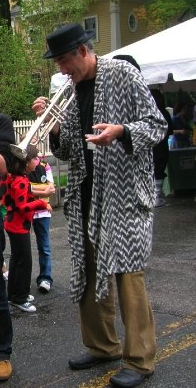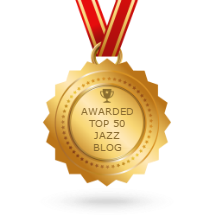While not really in the mix now, jazz has historically played the role that hip hop, some kinds of rock and video games now play. This short overview will look at mainstream perceptions of the relationship between jazz and "violence" and how that perception changed through time.
Jazz grabbed a lot of pieces of American culture to create itself: field shouts, preaching, spirituals, minstrelsy, blues, ragtime, parlor music, brass band music. Further, most of those were, themselves, hybrid strains.
.jpeg) Some of those influences, like spirituals, preaching and parlor music, self-identified as "genteel," or "uplifting." Some, like field shouts and hollers and blues, were labeled "slave music;" and were, by implication, "low." Minstrelsy and ragtime were associated with shakier morality-more urban, apt to indulge in "sophisticated" humor and often associated with houses of ill repute. Brass band music was energetic and its association with circuses(entertainment) reduced its moral tone. However, many of the trappings of performance-the military, the village green-were less suspect. Call it somewhere in between.
Some of those influences, like spirituals, preaching and parlor music, self-identified as "genteel," or "uplifting." Some, like field shouts and hollers and blues, were labeled "slave music;" and were, by implication, "low." Minstrelsy and ragtime were associated with shakier morality-more urban, apt to indulge in "sophisticated" humor and often associated with houses of ill repute. Brass band music was energetic and its association with circuses(entertainment) reduced its moral tone. However, many of the trappings of performance-the military, the village green-were less suspect. Call it somewhere in between.Each of these genres was also associated with the relative presence of, or lack of, violence. It's easy to see which was which.
By the turn of the 20th century, a music we now see as incipient jazz was being played by Buddy Bolden's group, Jelly Roll Morton and others. While it contained many musical influences, both "high" and"low," and was played at benign venues like parades and picnics, it was more closely associated with Storyville gut bucket joints, or the rough parts of cities like St. Louis and Memphis. Often described as wild and uncontrolled, the music was acquiring a specifically disreputable image.
Musicians in various cities were able to work both sides of the fence, playing improvisational music in joints and waltzes and quadrilles at balls and cotillions. With the unusual exception of James Reese Europe and the Clef Club in New York City, there was a racialist system which relegated darker-skinned musicians to gin joints, parades and lower-paying gigs, while whites or lighter-skinned creoles (in New Orleans) were able to work anywhere.
As the teens proceeded, there was more mixing among musicians and bands were expected to play many different kinds of "high" or "low-down" music, but by this point, jazz had provoked a serious moral backlash. Crusaders from many cultural niches helped to position it solidly as an anti-establishment music, associated with the demi-monde.
 |
| King Oliver and co. in Chicago |
The backlash against Prohibition and its eventual demise in 1933 coincided with the rise of "swing" music. The cultural perception of jazz shifted and the music became less something to epater le bourgeoisie and more something you'd play on the jukebox in the malt shop. During WWII, the music "played its part," helped to sell war bonds and became even less associated with violence (any irony there?).
.jpeg) |
| The Connection |
By the 1960's, jazz moved toward a more centrist moral/cultural position. A wave of spiritualism, spearheaded by John Coltrane and wider adoption of the Muslim religion by jazz musicians had defused the jazz-violence connection. Also, rock was now clearly the music of the counter-culture.
In the following decades, the common perception of jazz, to the extent it was thought about it at all, changed little. Rock musicians remained the bad boys until they were supplanted by hip hop artists. Video games then joined them under the public microscope.
Even though jazz always had one (sometimes small) foot in elite social circles, it also talked about things that gentility-or hypocrisy-precluded as part of the cultural dialogue and which, at the least, had overtones of violence. So, while there are "political" dimensions to any outsider-minority-generated art, mainstream moral codes, at least in America, have always exerted more of a sanctioning influence over jazz than has The State. Even during the 1950's, when the narcotics-jazz connection was widely noted, the State Department sent jazz musicians around the world to try and help win the Cold War.
The government has been too concerned with monitoring domestic political dissent and with its own overseas military campaigns, to pay much attention to the relationship of culture to violence on the home front. Even well-positioned crusaders like Tipper Gore have had a limited influence on government action.
The debate has been dominated by the people with the loudest voice and the most money (the NRA, if you haven't figured it out), who have successfully reinforced archaic myths of rugged individualism and the right to the untrammeled arming of our populace.


.jpeg)


.jpeg)
2 comments:
i would've never thought any of these things were at all connected or within the same scope, thanks for posting this
And thank you for reading.
Post a Comment